Affiliate disclosure: This post may contain affiliate links. Please see our Privacy Policy.
Fermented garlic honey is a simple homemade recipe for turning two everyday ingredients into an immune-boosting natural remedy.
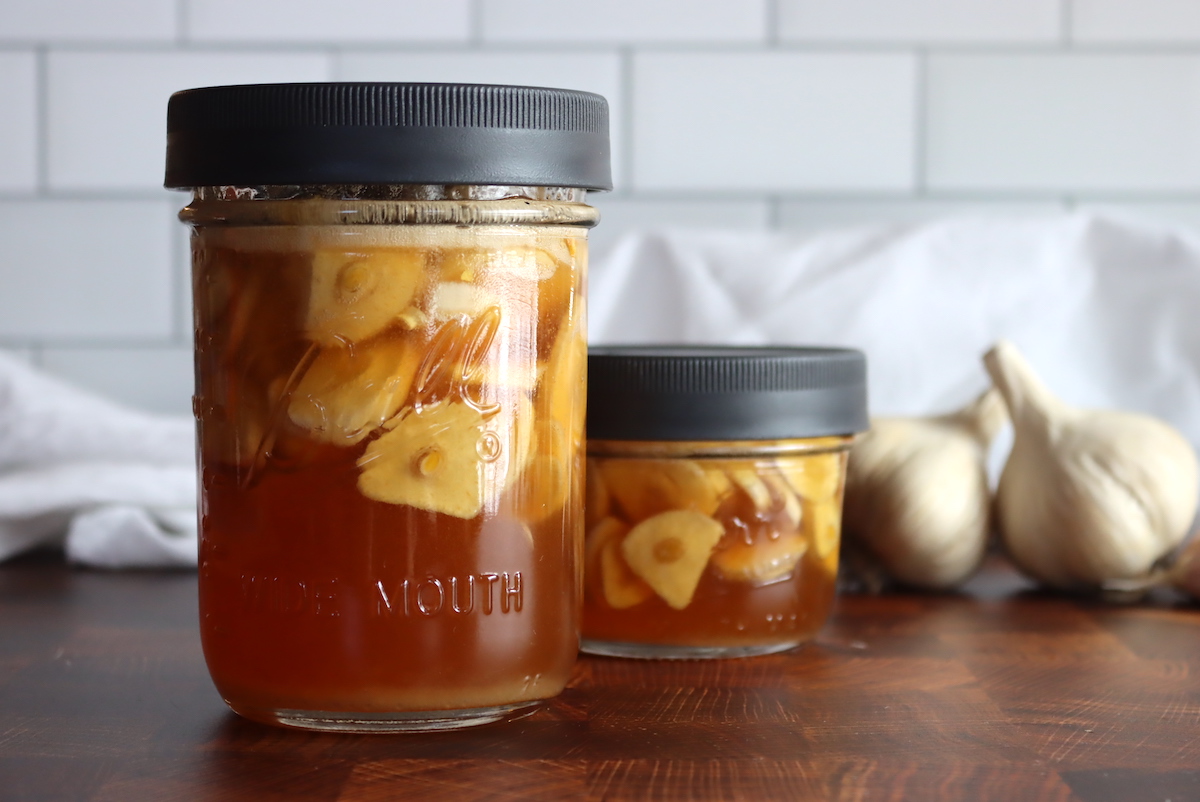
Table of Contents
Looking for an incredibly easy-to-make home remedy that incorporates ingredients you likely already have in your pantry? Look no further than fermented garlic honey!
A few years back, I saw this tutorial on my friend Colleen’s site and she describes fermenting garlic in honey to have on hand during cold and flu season.
What an incredible idea! I just had to try it myself with our own homegrown garlic.
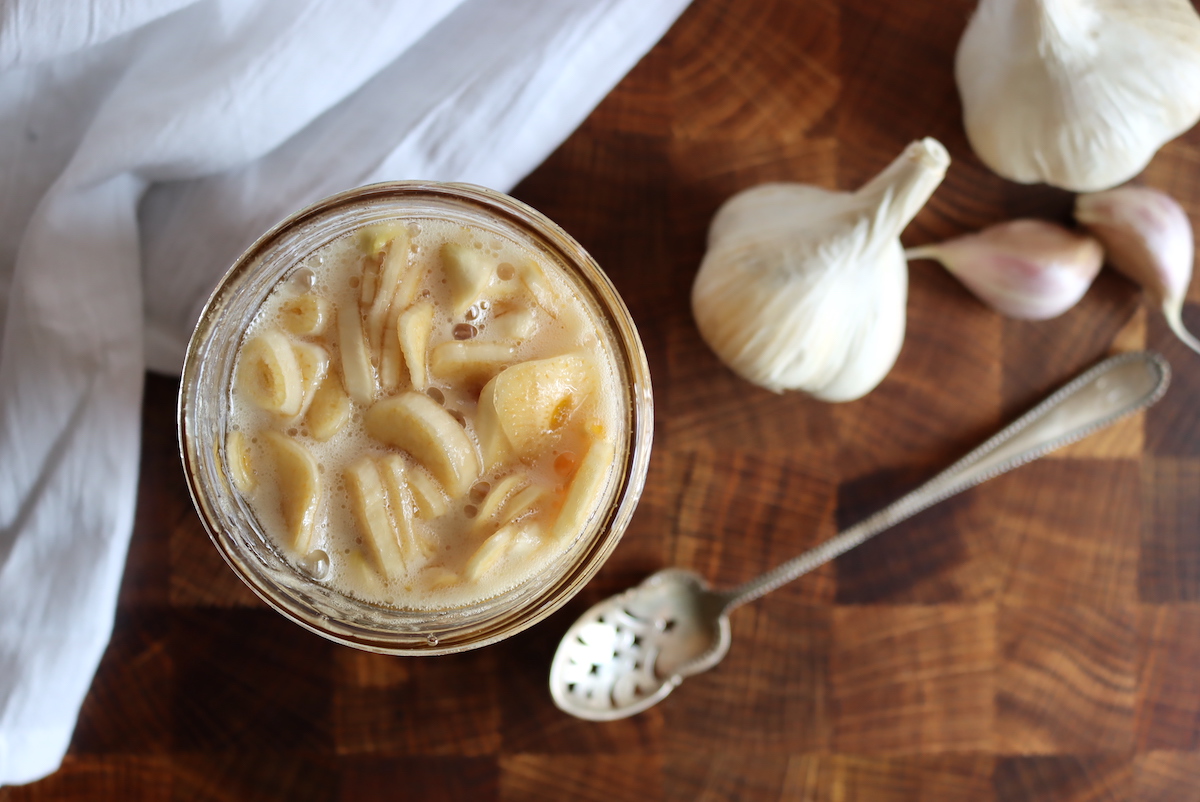
We grow an absurd amount of garlic each year, planting garlic in the fall, then harvesting garlic scapes in early summer before curing the bulbs to store away in our root cellar. The process repeats every single year, and on average we put up over 300 bulbs each season.
I add it to broths and stocks, make pickled garlic, and other than the occasional batch of fire cider, I haven’t really used it in home remedies.
We grow and forage dozens of different medicinal plants and make them into herbal preparations every year, but for some reason, I never really considered garlic “medicinal.” It is, in fact, a potent one with anti-inflammatory, anti-viral, and immune-boosting properties.
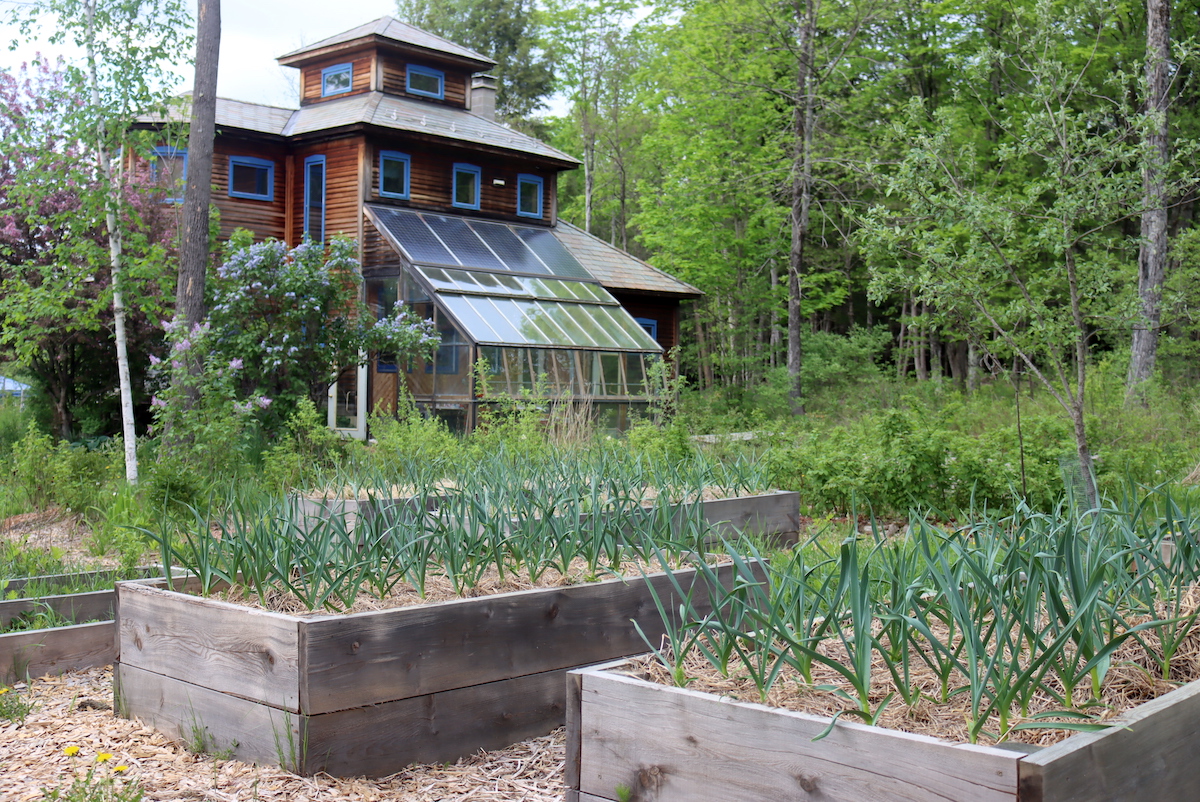
What is Fermented Garlic Honey?
It’s pretty simple and the name more or less says it all. Fermented garlic honey is just garlic cloves that are placed in honey and allowed to ferment for a few days.
Honey already contains yeast, and believe it or not, the bees are naturally attracted to flowers that have natural yeasts present. No one exactly knows why, but I have a sneaky suspicion that they know that a healthy ecosystem needs vibrant microbes.
Garlic has natural lactobacillus on its surface, which are the same microbes responsible for yogurt and homemade sauerkraut.
Add in the natural acetic acid (vinegar producing) bacteria in the air, and you’ve got a recipe for a potent mixture of healthy microbes.
The lactobacillus thrives in quick veggie ferments, in much the same way it does when making Lacto-fermented pickles. Any alcohol produced by the yeast in the honey is quickly converted to vinegar (in a process similar to making apple cider vinegar).
Benefits of Fermenting Garlic and Honey
So why on earth would you ferment garlic in honey?
The fermentation process makes the mixture probiotic, but it also helps make nutrients more bio-available. The same is true when you make fermented turmeric, and the anti-inflammatory compounds in turmeric are much more potent when it’s been fermented.
Honey is already a natural home remedy for sore throats and seasonal allergies, especially raw local honey.
Garlic has a long list of medicinal benefits, and studies show that it can help reduce the duration of the common cold by more than 70%. Beyond that, taking garlic regularly reduces your chances of getting sick altogether, resulting in fewer sick days every year.
Beyond that, garlic naturally reduces blood pressure and lowers cholesterol. There’s even some evidence that the antioxidants in garlic may help boost longevity and combat Alzheimer’s, but that’s research is still in the early stages.
By mixing honey and garlic, you not only make it more digestible through fermentation, you’re also combining two potent medicinals into one surprisingly tasty home remedy.
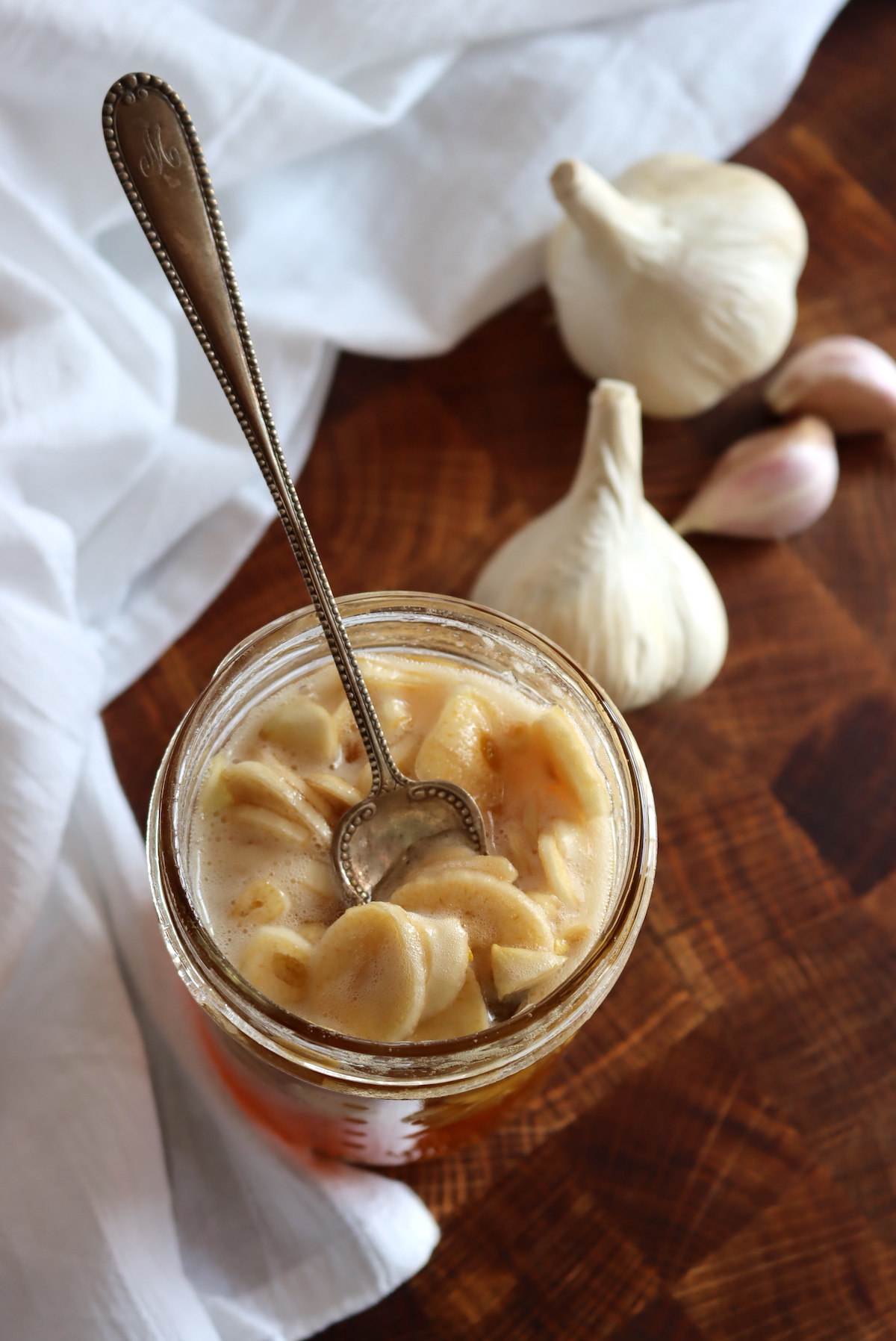
Is Honey Fermented Garlic Safe
Anytime you’re promoting microbes in the kitchen, people wonder if it is in fact safe to be doing so.
Lactobacillus, yeast, and acetic acid bacteria are completely safe and it’s really difficult to mess up a homemade ferment. With lacto-fermentation, it’s nearly impossible to make something that will cause harm, as the bacteria quickly outcompete just about everything else and acidify the mixture to prevent spoilage.
The same is true with yeast ferments like homemade beer, and acetic acid microbes that make homemade vinegar.
Believe it or not, the fermentation process is not at all an issue. The only potentially risky part here is actually the ingredients themselves.
The Herbal Academy discusses Garlic Honey in their Intermediate Herbal Course, and they note that,
“Honey and garlic can both harbor spores of Clostridium botulinum (the pathogen that causes botulism). The growth of C. botulinum spores is more likely to occur in a neutral pH, a moist environment, or an environment without oxygen. C. Botulinum spores are less likely to reproduce and the risk of botulism is lower in preparations with high acid (pH of below 4.6), high sugar, or high salt content. Honey is approximately 80% sugar, making it high in sugar. Honey is also acidic, with a pH of 3.9. Though many use this recipe as-is, because the honey is diluted by the garlic thus causing the sugar content to lower, some individuals choose to use a pH meter and add a splash of apple cider vinegar to keep the pH levels below 4.6.”
Since you’re encouraging lactobacillus here, the pH should naturally drop as the mixture ferments as well. Still, acting out of an abundance of caution, I add in about 2 tablespoons of apple cider vinegar per pint jar (more is fine too).
If you use raw cider vinegar, you’re also incorporating the probiotics from the vinegar mother, which will help quickly transition any alcohol produced to more vinegar (and thus add even more acidity).
Adding cider vinegar makes this a bit more like a herbal oxymel, which is a mixture of honey, herbs, and cider vinegar. Generally in oxymels, the balance of honey to vinegar is more even, and they’re commonly made with a 1:1:1 ratio of herbs:honey:vinegar. Many people make them sweeter, and some use a lot more vinegar, so the ratios are flexible.
(Alternately, you can place your fermenting garlic and honey in the refrigerator. Botulism is inhibited below 40 degrees F, but lactobacillus and yeast will still grow, just slowly. You can make the whole batch in the fridge, it’ll just take about 2-3 weeks instead of 3 to 5 days.)
Be aware that honey is never safe for infants and children under 2 years of age. Their stomach acid isn’t fully developed yet, and their stomach acts as a low acid environment. Do not use this remedy, or any remedy containing honey with children under 2 years old.
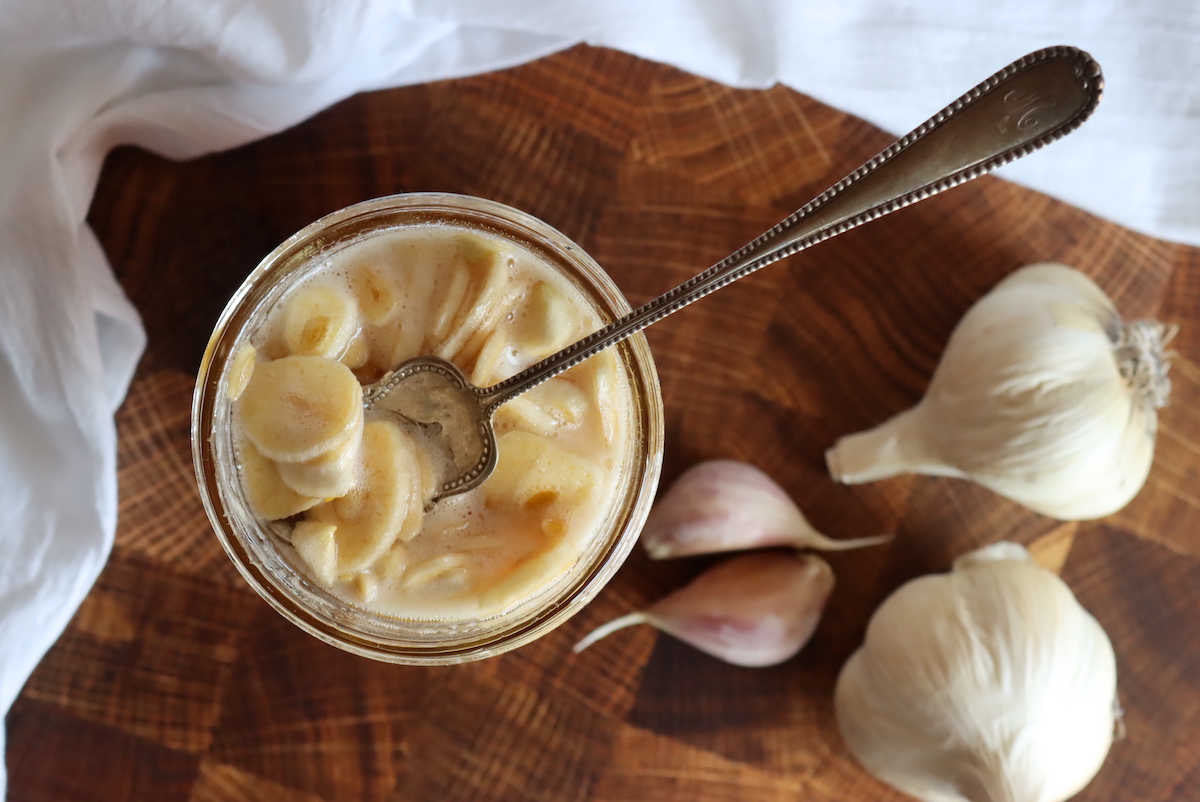
How to Make Fermented Honey Garlic
The basic process for making fermented garlic and honey is so simple that it hardly needs a recipe.
Start by peeling the garlic, trimming it to remove any discolored parts. It should be fresh healthy garlic to start, and garlic rarely spoils, but always check.
Slicing or chopping the cloves is optional, and if you’re working with the regular softneck garlic from the grocery store then it’s hardly necessary. Simply press the garlic clove with the side of a knife to gently bruise it, which will make it easier to peel. It’ll also help it release juice in the honey, allowing the ferment to happen more easily.
In my case, I’m using the hardneck garlic varieties that we grow here in Vermont. Hardneck garlic is great because it’s not only more flavorful, but it’s also much easier to peel. Since the cloves are so large it means a lot less peeling, but it also means you’ll have to chop the cloves for this particular recipe.
It has the same medicinal properties as regular garlic, and I have literally buckets of it from our garden, so that’s what I use. Below is a picture of the gigantic cloves in the jar, before I decided to slice them. An entire bulb is often 4 to 5 cloves, instead of the 12-20 cloves you get with soft neck garlic.
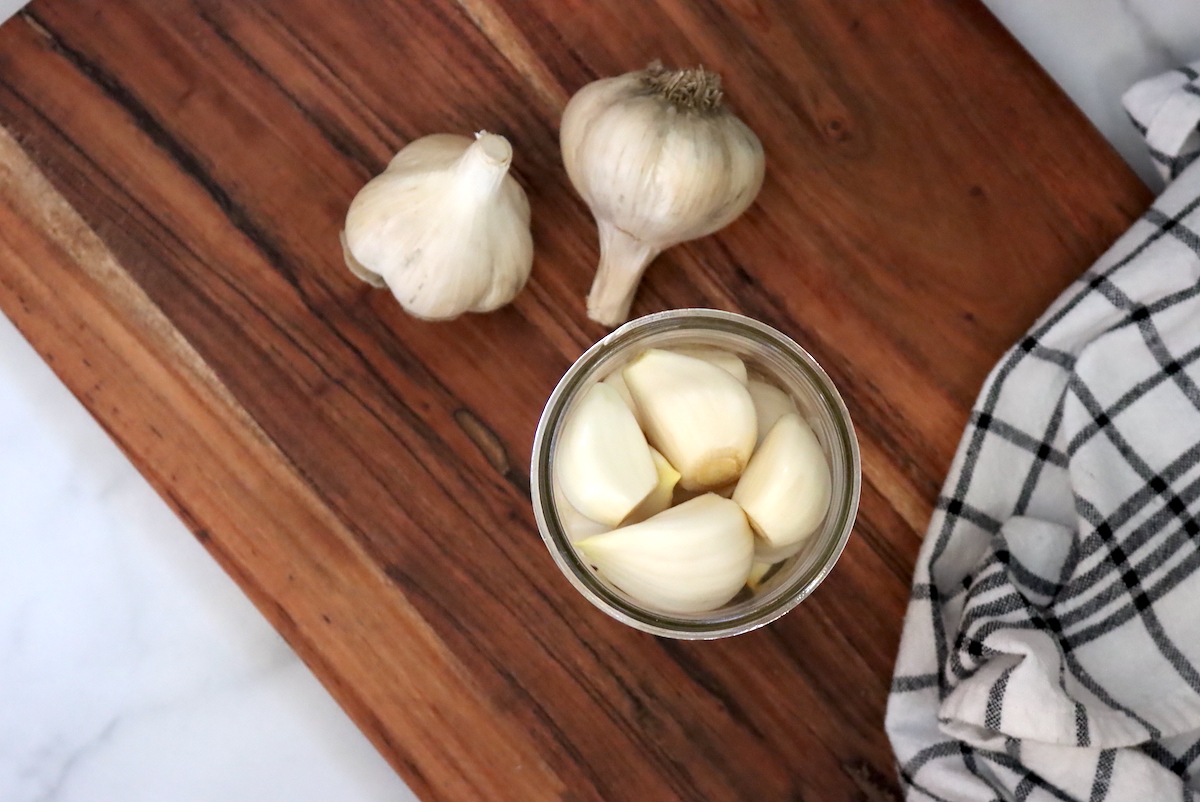
A side note here, “elephant garlic” has really large cloves but it’s not technically garlic. It’s different than hardneck and softneck garlic, and more or less a whole different species. It’s much milder in flavor, and honestly, I have no idea if it has the same medicinal properties.
Stick with regular softneck garlic, or if you’re in the northeast, you can use the absolutely wonderful hardneck garlic we grow here.
Once the garlic is in the jar, sliced or not, I’d recommend adding about 2 tablespoons of raw apple cider vinegar to the jar at this point. Give the jar a quick shake to coat the garlic cloves with cider vinegar. That ensures that the surface of the garlic starts acidic, which is a precaution against botulism. Likely unnecessary, but you can never be too careful.
(It also helps innoculate the jar with bonus acetic acid bacteria from the vinegar mother, which will boost the good bacteria, so it’s a nice addition even if you’re not worried about contamination.)
Next, add in the honey. I’d suggest filling the jar about 1/2 to 2/3 of the way with garlic, and then topping it off with honey to within an inch of the lid. Be sure to leave space at the top, as the mixture will bubble as it ferments and you don’t want it to overflow.
Cover the jar with a lid and flip it a few times to distribute the honey. Loosen the lid so gasses can escape during fermentation, and let the microbes go to work.
How Long Does it Take to Make?
You should see bubbles beginning to form in the honey after about 24 to 48 hours. After about 3 to 5 days, the activity should be calming down and the garlic should be well fermented.
If your house is cool, it may take around 7 to 10 days for things to calm down.
And of course, if you’ve made it in the refrigerator out of an abundance of caution, you’ll need to wait 2-3 weeks for the fermentation to complete.
After the initial burst of activity, fermentation activity will still be happening. It’ll still be active (just slower) for another month or two as the microbes slowly continue to work. You can eat the fermented garlic honey at any point after the first 48 hours, and really, you could eat it fresh too…it just won’t be fermented.
How Long Does Fermented Garlic Honey Last?
Once the initial fermentation activity is over, you should try to keep your honey garlic in a cool place. A basement works well, as does a back closet on the north side of the house. The refrigerator works wonderfully too, and is more dependably cool. It’s not strictly required though.
This ferment will keep for many months, and really the only risk of spoilage is if the garlic floats above the honey surface too long and starts to mold. (That same thing happens with sauerkraut and other ferments too if the liquid level drops.) To prevent that, just give your mixture a shake every week or so to redistribute the garlic below the surface.
If kept cool, the mixture should be good for several months, or even up to a year in ideal conditions.
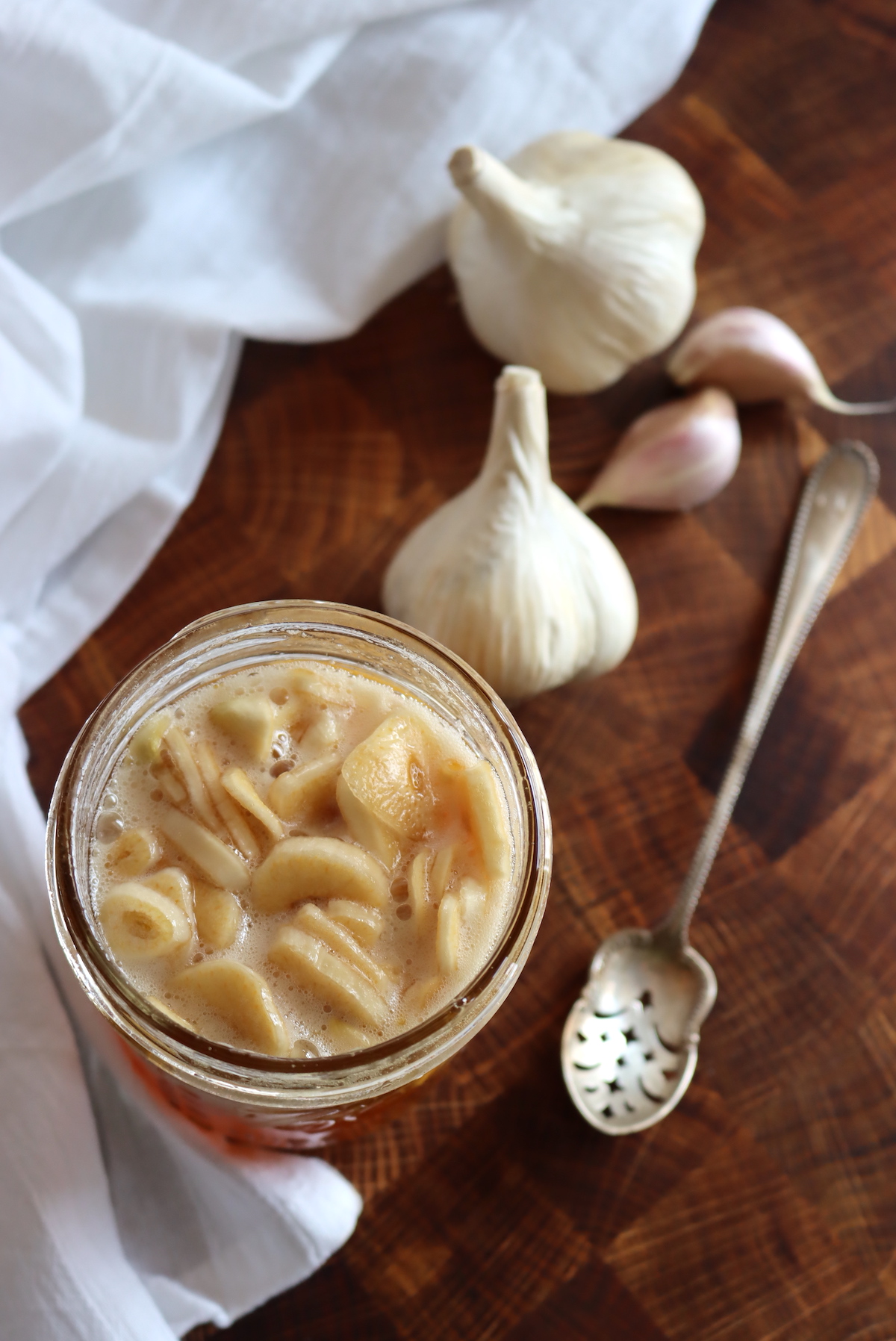
How do you Eat Honey Fermented Garlic?
The fermentation process actually mellows the flavor of garlic, making it less spicy and abrasive. Don’t get me wrong, it still tastes like garlic, but it’s milder, creamier, and just more mellow on the tongue. If you like the taste of garlic, but just can’t stand the heat, I think you’ll really enjoy the cloves right off a spoon.
Though mixing sweetness with garlic may seem strange, it’s actually pretty common in cooking. Just look at Asian cuisine, and just about any dish you’d pick up for take-out has a sweet/garlic mix in the sauce, from teriyaki to General Tso’s chicken. Beyond that, any bbq sauce or marinade will likely mix sweet flavors with savory garlic, and many salad dressings too.
Garlic that has been fermented can be eaten right off the spoon or incorporated into any of those recipes.
The fermentation process makes the honey darker and more liquid, and it takes on a mellow flavor of the fermented garlic as well. I think it makes a lovely tonic eaten right out of the jar on a spoon, and it’s especially comforting if I have a respiratory issue (cough, cold, etc) or a sore throat. The honey can also be incorporated into savory/sweet recipes.
If you choose to add a splash of apple cider vinegar to the mix, the subtle acidity will help balance the sweetness of the honey and actually makes it a better syrup. It works well regardless of whether you intend to use your garlic honey as a remedy as is, or in cooking.
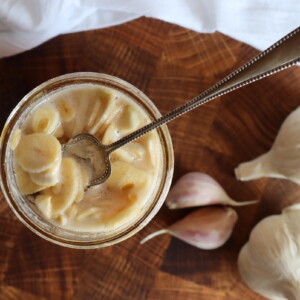
Fermented Garlic Honey
Ingredients
- 1 to 1 1/2 cups garlic cloves, peeled
- 6 ounces 170 g honey (raw & local if available)
- Raw Apple cider vinegar, optional, see note
Instructions
- Peel the garlic and gently bruise it with the side of a knife. The cloves can be left whole if they're small, or sliced if larger. Place them into a pint jar.
- If using cider vinegar, add 1 to 2 tablespoons of vinegar to the jar. Cap the lid and give it a shake to coat the garlic. This is optional but helps ensure food safety out of an abundance of caution. It also helps to innoculate the jar with the raw vinegar mother microbes to aid in fermentation. A small amount of added acidity also improves flavor. (See article for details)
- Open the jar and pour in about 6 ounces of honey. It should completely cover the garlic and fill the jar to within about 1'' of the top. Be sure to leave 1'' headspace as the mixture will bubble as it ferments. Cap the jar and flip it over a few times to distribute the honey.
- Loosen the cap to allow gasses to escape during the fermentation process, and allow the jar to ferment at room temperature for 2 to 5 days. The mixture can be used at any point during fermentation. After about 5 days, place the jar in the refrigerator or a cool place to slow fermentation.
- Fermented garlic honey can be used at any point after the first 48 hours. It'll keep for many months, provided you give it a shake every once in a while to keep the garlic submerged. Keep the cap loose when you're not shaking it so the gasses produced during fermentation can escape. Store in a cool place after the initial fermentation is complete to slow the process down and help maintain quality.
Homemade Herbal Remedies
Looking for more ways to stock your herbal medicine cabinet?
- How to Make a Herbal Salve
- How to Make a Herbal Infused Oil
- How to Make a Herbal Tincture
- Homemade Herbal Shampoo
- How to Make Lotion Bars
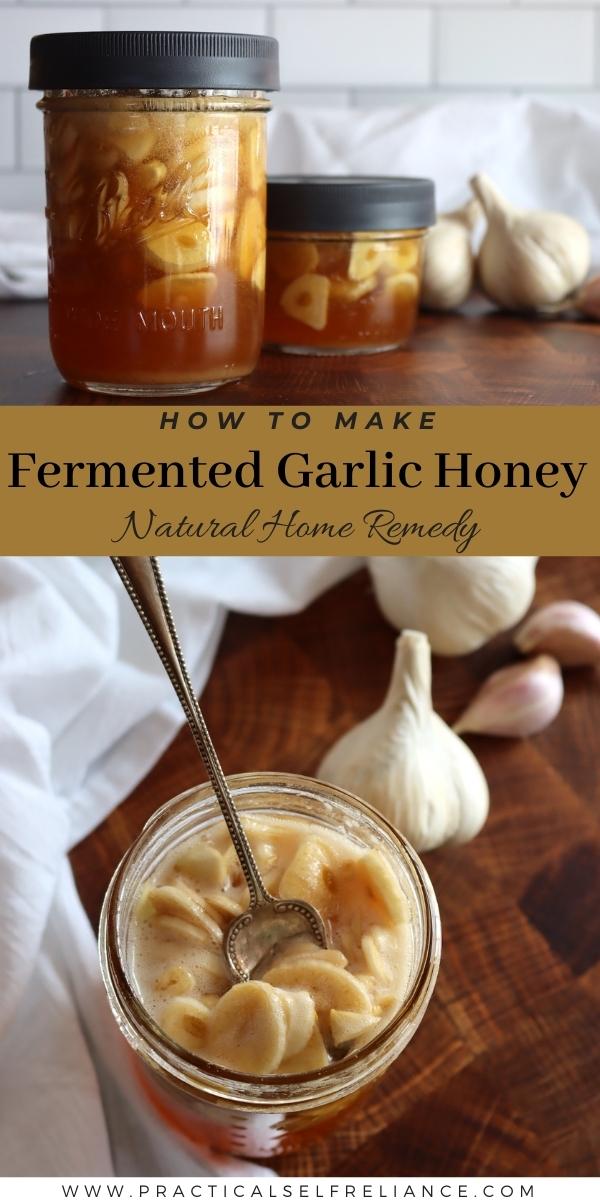


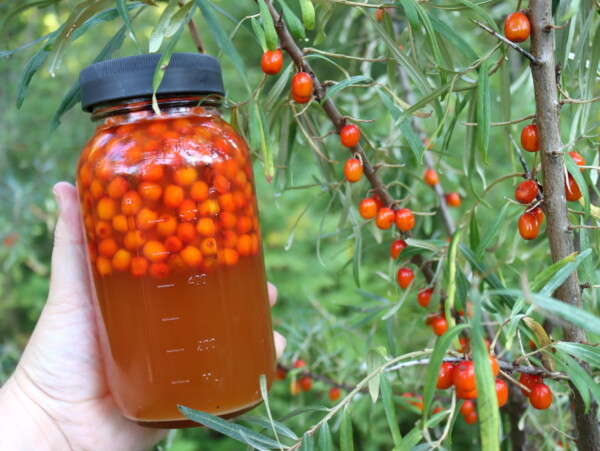
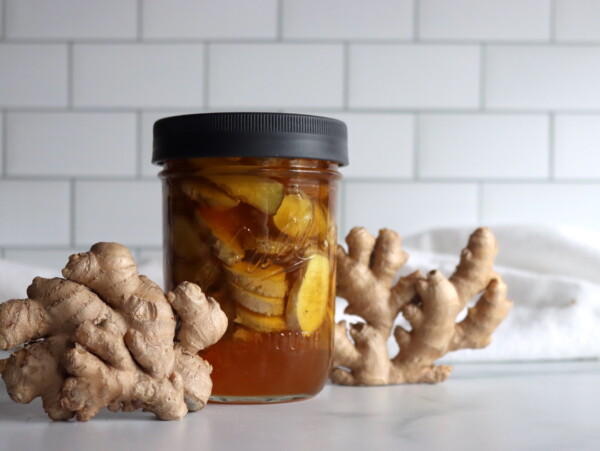










Could ginger be added to the garlic/ honey mixture or is it better to only do one or the other?
You could make a combined batch, that’s totally fine. Enjoy!
You mentioned that you don’t know if the elephant garlic and small garlic has the same medicinal properties. I can attest to it does. Back in 1989 I was being poisoned with arsenic and did not know why I had so many health problems. The only thing I knew to do was juice garlic and mix it half and half with olive oil and keep in the frig with an eyedropper. Every day I would fill capsules with it and take them. It kept me alive! Fast forward to 4 years later and I was reading books on Candida which had all the symptoms I was having before. I just never regained my strength. I found an OB/GYN who was open to natural healing and she tested me. Results came back arsenic poisoning, the level she said should have killed me. I told her it was God who kept me alive! Fast forward again to 2003 and I start learning TCM. The Chinese herbs are what it took to gain my strength back from the voids the arsenic left in my body.
That’s a great story. Thanks for sharing.
Hi Ashley! I can’t wait to make this. Every other recipe of yours I’ve tried has been a huge success! Is it okay to make this in jars with the burping tops and weights if I pinch them closed when flipping/mixing?
Yes, that should work just fine.
Hey Ashley! I just made a batch of this yesterday. One with whole garlic cloves and another one with chopped garlic. Today I went to check on them and the one with the chopped garlic has so much liquid floating… I guess its the garlic juices… What should I do with it? Discard de liquid? Just let it be there? I’m not sure…. Grateful for any tips you can give me 🙂
I wouldn’t discard the liquid. It should eventually all mix in. You will get liquid eventually with the whole cloves as well. It just takes a little more time.
Hello and thanks for writing this article! I started a jar about 2 weeks ago and noticed the honey separated and some of it hardened. I know this happens sometimes but wonder if it changes anything for this purpose. I’ve been turning and popping the lid but the stuff is still stuck at the bottom of the jar, even when upside down.
It’s been kept in a cool dark closet, likely 70 degrees or less
I wouldn’t worry about it. It should be just fine.
Hi, thanks for the recipe and insights. I am very new to all of this. Is there a point where the lid should be sealed tightly permanently, rather than left loose? (besides when you are flipping the jar around). Like does the fermentation process end, or does the lid forever need to be a little loose to allow for gasses to escape?
It should stop fermenting after about a month. If you choose to tighten the lid, I would just keep an eye on it.
I’ve made a few jars of this and love it. But I recently left the lid off by mistake for 6 hours. Is it still potent and effective?
Yes, it should still be fine.
I made my first batch yesterday afternoon, or tried to, and this morning when I got up, the garlic cloves were all turning green. Plus, they wouldn’t stay beneath the surface of the honey.
I put ACV in it also. Did I put too much ACV? Like, I made it too liquidy so the garlic couldn’t stay submerged?
I would just make sure that you are shaking the mixture on a regular basis so that the garlic doesn’t stay above the surface for an extended period of time. If it’s more liquidy then it will definitely have more of a tendency to float to the surface. You can also use something to weigh the garlic down in the jar if you wish.
I love the idea of this recipe!! I made a jar of it, followed your recipe to a T and have had it on the counter in a warm kitchen (70F) for about 5 days now. I see little tiny bubbles when it’s still then after I tip it upside down a few times there are a lot of bubbles but not like the foamy bubbles in your pictures. Do you think my bubbles are just air? I used organic garlic, Michigan Raw unfiltered honey from our local Costco. zI also did what you said and added ACV before the honey. Do you think Costco is lying and it’s not real honey? It smells great but I haven’t tasted it yet. Do you think it’s done?
TIA
I would say that it is probably done by now. If you taste it, the garlic should be more mellow. I say give it a try and see what it tastes like.
Thanks so much. I did taste it and it was good but the garlic is still fairly “hot”. I put a weight in the jar and covered it with a brupable lid! I’m going to let it go a bit longer. How long before I have to put it in the fridge to not have it go bad?
It’s not actually required to refrigerate it at all. Many people leave it out. You do want a fairly cool location once the fermentation is done.
Thanks for all the good information.
You’re very welcome.
Is it normal for the smell to be kinda gross? 🤪 we’re in day 3 or 4 lots of activity it’s just very off putting.
Fermentation often produces a different smell for sure but it shouldn’t be gross.
I’ve been making this for years!
I use the honey on chicken wings & eat the garlic cloves as is daily for good health. I generally start using it after it’s been fermenting minimum 6 months & after a year it’s still amazing!
Wonderful!
I’m learning, and struggling, to get this right! I used local, raw honey, and organically grown garlic. It went exactly as described…..bubbling for the first 3-ish days, then settling down. For the first two weeks, I was diligent about turning the pint jar over, and left the lid loose, afterward. It ran down into the bowl the jar is resting in, so I thought all was well.
It’s been a month and 2 days now, so I used a PH testing strip to see where it is. It’s very dark, at about 6.0! Actually, the strip didn’t even change color!
What do I do? Do I add some ACV? Can I save it? Thanks!
That’s really crazy! I’d honestly think there’s something off about your pH strips? Do they turn color if you put them into lemon juice or vinegar?
I hadn’t thought of that. I tried a strip in my ACV, and it turned to about 2.0. So they seem okay. I added about 1.5 T of ACV to my jar of honey and garlic. Even if it doesn’t technically ferment, I at least want to be able to safely ingest it!
Don’t know what I’m doing wrong, though. This is the second batch to do “lose the ferment”. Or, that’s what it seems to do. I’m new at this, so I really have no idea what’s happened!
Can you reuse the garlic? Add more honey as you use it up? I know it’d be weaker but thought I’d ask. Thank you!
It definitely wouldn’t be as potent but I don’t see any reason why you couldn’t do that.
I soaked the garlic cloves in vinegar overnight next day poured it off next day.
Then I. poured honey over the drained cloves as the days went by the garlic is turning a faint color of blue/ green is it still ok?
I’ve read that vinegar can turn garlic a color. Please send answer thanks.
Sherry Smith
Yes, it is common for garlic to turn colors when it comes into contact with a very acidic environment, especially with older garlic. This does not mean that the garlic isn’t good and shouldn’t make you sick. It just looks unappealing.
Doesn’t seem like the honey is fermenting like it should did the vinegar interrupt the process?
Yes, I would say that it probably did.
Several articles re: fermenting garlic honey have said that adding some apple cider vinegar would alleviate any worry about botulism. Your answer here concerns me as I was going to add some ACV to the batch I’m getting ready to make. Thought a bit of ACV wouild also add some of the benefits of ACV to the infusion as well. Thoughts on this? What amount of ACV would be good but not end up “interruptting the process” Thanks for any ideas or guidance on this for a newbie to all this.
I’m not entirely sure why that answer is there to be honest. The post recommends about 2 tablespoons per pint jar, so I would just stick with that amount.
You mentioned that the garlic should stay submerged to counteract any mold growing. How do you keep it thst way? Just staryed and it floats to top.
It will naturally float to the top. This is not a problem unless it sits above the honey for too long. You just want to give it a quick shake on a regular basis to keep this from being an issue.
I have found out that there is fake honey on the market. I don’t have access to any local or raw honey. How do I tell what is real honey and what is fake honey?
I know, that’s incredibly disappointing! I’ve heard that a lot too, and it’s one reason we stopped buying from a number of places. Trusting your local farmer is definitely the best way, but actually testing it in a lab is the only other way. (There’s no good way to tell at home.)
I do know that these people have amazing honey, and they ship, so that might be a good source: https://www.champlainvalleyhoney.com/
Hi, Ashley!
Thank you for sharing this! I made a jar of this, for my first time, a month or so ago, but haven’t used it, yet. I didn’t use the acv, but it smells divine. Does the honey still have all the benefits of the garlic, once the garlic is all gone? I’m a family herbalist, and a big fan of the honey garlic flavor and health benefits – and I’m dying to get into that garlic, for some salad dressing (also my favorite use for my fire cider)!
Yup! You’ve basically made an infused honey there, so once the garlic is removed, it should be infused with the medicinal constituents of the garlic. (We do a similar thing with valerian in honey, and all the herb is strained out but we use the valerian honey in our bedtime teas.)
Thank you, for your quick response! The infusion was what I was aiming for, but it’s my first time doing a honey infusion. I usually do vinegar or oil Infusions, then add honey, afterward, for a wide variety of oxymel purposes and flavors (one of my favorites is a mulled elderberry oxymel). Considering the thickness of the honey, I wasn’t really sure how long it would take, how deeply it would Infuse, etc, so I’ve been reluctant to dig into it too soon.
You can feel free to enjoy it at any time and then continue to allow it to infuse.
I picked up a jar of garlic honey at the gardening expo in CT a few weeks ago. It’s so tasty! Any ideas on how to cook with this? I would love to make a meal with this blend but I haven’t figured out how to incorporate it in.
I haven’t ever used it in cooking before. I would suggest doing a quick internet search for cooking with fermented honey garlic and see what recipes you can find. I would recommend staying away from actually cooking the honey though since the heat can destroy a lot of the beneficial bacteria.